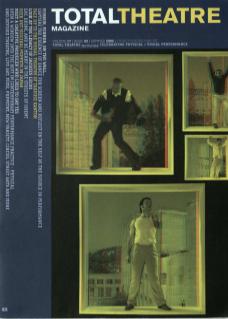A black canvas played host to a brilliant sea of pink Nelken (carnations) – I immersed myself, three rows from the stage, just above the carnation line...
This was my first live experience of Bausch’s work and already I felt thrilled as a child at the pantomime. From a visual perspective, the composition of objects, performers and lighting was exquisite, worthy of a painting, a mesmerising use of space, light and depth. It had the quality of a menacing dream full of seemingly random yet highly symbolic imagery all intensely resonating, almost luminescent. The performers seemed to come in droves like an army – occupying, mediating and delivering the space. And what was impeccably arranged and beautifully presented had a darker chaotic undercurrent. Speaking to us directly and unashamedly, their worn, torn, athletic bodies were defiant; in a childlike fashion they pranced, stormed, strutted and stomped. They played the joyful yet brutal childhood games of the playground, a metaphor for life experiences. Recognisable everyday actions were given neurotic attention, repetition, distortion, exaggeration, reaching tipping point as an emotional cascade was unleashed upon us. A woman is force-fed food, another spoons soil over her head, proof of identity is continuously questioned by officious characters, and men cavort in dresses under the threatening presence of guards and dogs. At times the performers came too close, tried too hard, appeared self-indulgent. But as Nelken came to a close the performers emerged ever-resolute standing in a sea of battered carnations. Though I found it very compelling, I was not particularly moved. I think that I have already seen and been inspired by the Pina Bausch legacy. It was rather like seeing all the pieces of a jigsaw puzzle finally together.
Sarah Corbett
Since seeing Palermo Palermo, I have been moving my iron around the kitchen – hiding it really – lest it remind me of the semi-naked man toasting morsels of his own flesh on an iron and devouring them with gusto. The power of this scene perfectly sums up Pina Bausch as a director of visual theatre: the image is arresting, hilarious and disturbing. So camp, so theatrical, so un-naturalistic yet so real. The character enacting the scene is both muscle-man and drag queen, could be Adonis or Christ. The eating of his flesh suggests a whole raft of associations with Palermo, capital of Sicily, city of sex, death, passion, feasting, sacrifice, brotherhood and bloodletting. This scene is just one of many magic moments in this three-hour marathon (one of a number of pieces Bausch created in the 80s which investigates the psycho-geography of place). Moving pictures pass before our eyes, a feast of breathtaking images: brick walls tumbling down, releasing clouds of red dust, a Magdalenesque sweeping of the floor with hair; a ‘mine, all mine’ manic devouring of spaghetti; pink blossomed trees elevated on pulleys whilst we hear the tale of the Geese and the Fox. And through, around and between it all, the twenty-four-strong cost dance their socks off. There are solos, duets and exuberant and beautiful tag-dancing on a rubbish-strewn stage. Dances of flicking hair and flowing circular movements – those wrists, those elbows! – interrupted by staccato bursts of repetitive movements. The dancers are all so different it is a joy to see the variety of humankind presented on stage – yet all are unmistakably Bausch, her signature written on their bodies.
Dorothy Max Prior

